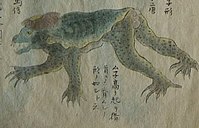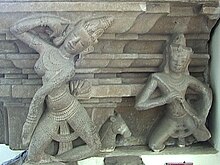| (Gatarō, Kawako) | |
|---|---|
 A drawing of a kappa. | |
| Creature | |
| Grouping | Legendary creature |
| Sub grouping | Sprite |
| Data | |
| Mythology | Japanese mythology |
| Country | Japan |
| Habitat | Rivers |
Kappa (河童, "river-child"), alternately called Kawatarō (川太郎, "river-boy") or Kawako (川子, "river-child"), are legendary creatures, a type of water sprite found in Japanese folklore.[1][2] In Shintō they are considered to be one of many suijin.[3] A hair-covered variation of a Kappa is called a Hyōsube (ひょうすべ).[4]
Kappa are similar to Scandinavian Näkki, Germanic Neck and Scottish Kelpie in that all have been used to scare children of dangers lurking in waters.
Contents |
Appearance
Most depictions show kappa as child-sized humanoids, though their bodies are often more like those of monkeys or frogs than human beings. Some descriptions say their faces are apelike, while others show them with beaked visages more like those of tortoises or with duck beaks. Pictures usually show kappa with thick shells and scaly skin that ranges in color from green to yellow or blue.[5][6][7]
Another notable feature of the kappa is the saucer-shaped depression on their scalps, which must at all times be filled with water if the kappa is to retain its strength and powers. Should the depression be emptied of water, the kappa will instantly be weakened and may even die if the water is not restored.
Kappa supposedly inhabit the ponds and rivers of Japan and have various features to aid them in this environment, such as webbed hands and feet.[8] They are sometimes even said to smell like fish, and they can certainly swim like them. The expression kappa-no-kawa-nagare ("a kappa drowning in a river") conveys the idea that even experts make mistakes.[9]
[edit] Behavior

Kappa are usually seen as mischievous troublemakers. Their pranks range from the relatively innocent, such as loudly passing gas or looking up women's kimonos, to the more troublesome, such as stealing crops or kidnapping children. In fact, small children are one of the gluttonous kappa's favorite meals, though they will eat adults as well. They feed on these victims by sucking out their shirikodama (尻子玉), a mythical ball inside the anus.[10][11] Even today, signs warning about kappa appear by bodies of water in some Japanese towns and villages. Kappa are also said to be afraid of fire, and some villages hold fireworks festivals each year to scare the spirits away.
It was believed that if confronted with a kappa there was but one mean of escape: kappas, for one reason or another, obsess over being polite, so if you were to gesture a deep bow to a kappa it would more than likely return it. In doing so, the water kept in the lilypad-like bowl on their head would spill out and the kappa would be rendered unable to leave the bowed position until the bowl was refilled with water from the river in which it lived. If a human were to refill it, it was believed the kappa would serve them for all eternity.[12]
Kappa are not entirely antagonistic to humankind, however. They are curious of human civilization, and they can understand and speak Japanese. They thus sometimes challenge those they encounter to various tests of skill, such as shogi or sumo wrestling.[2] They may even befriend human beings in exchange for gifts and offerings, especially cucumbers, the only food kappa are known to enjoy more than human children. Japanese parents sometimes write the names of their children (or themselves) on cucumbers and toss them into waters believed to be infested with kappa in order to mollify the creatures and allow the family to bathe.[13] There is even a kind of cucumber-filled sushi roll named for the kappa, the kappamaki.[12]
Once befriended, kappa have been known to perform any number of tasks for human beings, such as helping farmers irrigate their land. They are also highly knowledgeable of medicine, and legend states that they taught the art of bone setting to humankind.[12][14][15] Due to these benevolent aspects, some shrines are dedicated to the worship of particularly helpful kappa.[16] Kappa may also be tricked into helping people. Their deep sense of decorum will not allow them to break an oath, for example; so if a human being can dupe a kappa into promising to help him, the kappa has no choice but to follow through.
[edit] See also
| Wikimedia Commons has media related to: Kappa |
- Kappabashi-dori, a neighborhood in Tokyo. Kappa here is a homophone, but the homophony is exploited.
- Summer Days with Coo 2007 Anime
- The Pokemon Golduck.
- Koopa Troopa, the main enemy in the Mario series.
- Kapp'n, a sailor, taxi driver, and bus driver in the Animal Crossing series.
[edit] References
- ^ Bush, Laurence C. (2001). Asian horror encyclopedia: Asian horror culture in literature, manga and folklore. Laurence C. Bush. p. 94. ISBN 0-595-20181-4. http://books.google.com/books?id=lesg5YSXckQC&pg=PA94&dq=kappa+Kawako&as_brr=3&hl=ja&cd=4#v=onepage&q=kappa%20Kawako&f=false.
- ^ a b Foster, Michael Dylan (2009). Pandemonium and parade: Japanese monsters and the culture of yōkai. University of California Press. p. 46. ISBN 978-0-520-25361-2. http://books.google.com/books?id=Z5WQy5Q6Hj4C&pg=PA46&dq=kappa+kawataro&num=100&as_brr=3&cd=1#v=onepage&q=kappa%20kawataro&f=false.
- ^ Frédéric, Louis (2002). Japan encyclopedia. President and Fellows of Harvard College. p. 910. ISBN 0-674-00770-0. http://books.google.com/books?id=p2QnPijAEmEC&pg=PA910&dq=kappa+suijin&num=100&cd=6#v=onepage&q=kappa%20suijin&f=false.
- ^ "怪異・妖怪伝承データベース: カッパ, ヒョウスベ [Folktale Data of Strange Phenomena and Yōkai]" (in Japanese). International Research Center for Japanese Studies. http://www.nichibun.ac.jp/YoukaiCard/2220015.shtml.
- ^ Davis, F. Hadland (1992). Myths and legends of Japan. Dover Publications. p. 350. ISBN 0-486-27045-9. http://books.google.com/books?id=10WXp8fNeqwC&pg=PA350&dq=kappa&num=100&as_brr=3&hl=ja&cd=1#v=onepage&q=kappa&f=false.
- ^ Volker, T. (1975). The animal in Far Eastern art and especially in the art of the Japanese. E.J.Brill. p. 110. ISBN 90-04-04295-4. http://books.google.com/books?id=XyEVAAAAIAAJ&pg=PA110&dq=kappa&num=100&as_brr=3&hl=ja&cd=5#v=onepage&q=kappa&f=false.
- ^ Frédéric, Louis (2002). Japan encyclopedia. President and Fellows of Harvard College. p. 480. ISBN 0-674-00770-0. http://books.google.com/books?id=p2QnPijAEmEC&pg=PA480&dq=kappa&num=100&cd=6#v=onepage&q=kappa&f=false.
- ^ Mack, Dinah (1998). A Field Guide to Demons, Fairies, Fallen Angels, and Other Subversive Spirits. Carol K. Mack and Dinah Mack. p. 17. ISBN 1-55970-447-1. http://books.google.com/books?id=1IDS3UUrqAIC&pg=PA17&dq=kappa+japan&num=100&as_brr=3&hl=ja&cd=4#v=onepage&q=kappa%20japan&f=false.
- ^ Buchanan, Daniel Crump (1965). Japanese Proverbs and Sayings. University of Oklahoma Press. p. 42. ISBN 0-8061-1082-1. http://books.google.com/books?id=wGb4zNqYj10C&pg=PA42&dq=kappa-no-kawa-nagare&num=100&cd=1#v=onepage&q=kappa-no-kawa-nagare&f=false.
- ^ "Shirikodama". tangorin.com. http://tangorin.com/words/shirikodama.
- ^ Nara, Hiroshi (2007). Inexorable modernity: Japan's grappling with modernity in the arts. Lexington Books. p. 33. ISBN 0-7391-1841-2. http://books.google.com/books?id=bMMusu0O4zAC&pg=PA33&dq=kappa+shirikodama&num=100&as_brr=3&hl=ja&cd=1#v=onepage&q=kappa%20shirikodama&f=false.
- ^ a b c Ashkenazi, Michael (2003). Handbook of Japanese mythology. Micheal Ashkenaze. p. 195. ISBN 1-57607-467-6. http://books.google.com/books?id=gqs-y9R2AekC&pg=PT195&dq=kappa#v=onepage&q=kappa&f=false.
- ^ "怪異・妖怪伝承データベース: 河童雑談 [Folktale Data of Strange Phenomena and Yōkai]" (in Japanese). International Research Center for Japanese Studies. http://www.nichibun.ac.jp/YoukaiCard/0030086.shtml.
- ^ "怪異・妖怪伝承データベース: 河童の教えた中風の薬 [Folktale Data of Strange Phenomena and Yōkai]" (in Japanese). International Research Center for Japanese Studies. http://www.nichibun.ac.jp/YoukaiCard/0160053.shtml.
- ^ "怪異・妖怪伝承データベース: 河童の秘伝接骨薬 [Folktale Data of Strange Phenomena and Yōkai]" (in Japanese). International Research Center for Japanese Studies. http://www.nichibun.ac.jp/YoukaiCard/C0411189-000.shtml.
- ^ "怪異・妖怪伝承データベース: 河童神社 [Folktale Data of Strange Phenomena and Yōkai]" (in Japanese). International Research Center for Japanese Studies. http://www.nichibun.ac.jp/YoukaiCard/C0410236-000.shtml.
Read more: http://wawanwae.blogspot.com/2009/01/cara-membuat-related-post-posting.html#ixzz0rTVhPOvn







